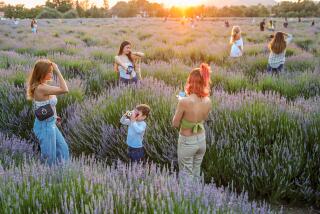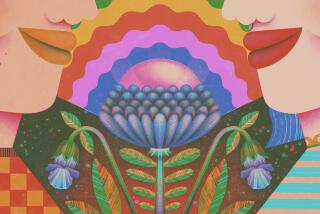France Overcomes the Lavender Blues
- Share via
PARIS — Lavender and grandmothers, the two have long been inextricably linked. It’s a pleasant connection, perhaps, but a bit limiting in terms of marketing potential.
First farmed during World War I, when it was used at the front for its antiseptic qualities, the bluish violet shrub was consigned largely to old women’s clothing drawers and herbalists’ cupboards in the latter part of the 20th century.
But these days, lavender is sporting a younger, classier image. It boasts a place on stylish cosmetic and perfume counters, and its soothing scent makes it a vital ingredient in every aromatherapy kit. It has even lent its colors to the fashion world’s catwalks.
“Lavender is fashionable again,” said Patrick de Laurens, a perfume and medicinal plant industry executive. “It has shaken off its old image and is no longer just thought of in terms of sachets that our grandmothers put between their clothes. Now it can be found on the shelves in so many different guises and in products the young like to buy too.”
It is a marketing turnaround that warms the hearts and fills the pockets of France’s 400 lavender growers.
To celebrate this year’s harvest and the plant’s revival, French growers, who produce 70% of the world’s essential lavender oil, have brought their spindly, sweet-smelling shrub to one of Paris’ most famous squares.
The colorful, heavily scented invasion of the Place des Vosges from the Haute Provence and other regions in the sunnier southeast brings with it a simple message: After being rescued from the brink of collapse, France’s lavender industry is back and showing no signs of its former stuffy image.
Its new fashionable look is all tied up with tourism and “the good life” associated with southern France.
“The image of Provence is intimately connected with lavender. Each conjures up images of sun, good living, health, beauty, and the two feed off each other,” said lavender distiller Patrick Pellerin, who wore the purple and green robes of his lavender fraternity to the Paris celebration.
Pellerin and his fellow southerners’ deep tans distinguish them from their paler Parisian hosts and also illustrate the healthy lifestyle with which the lavender industry believes its beloved plant has come to be connected.
Such an event might be somewhat indulgent trumpet blowing, but the presence of both the agriculture and tourism ministers demonstrates just how important lavender is for the economy of southeastern France.
Had it not been for a government and European Union-backed rescue plan, it might have disappeared as a viable industry. After peaking at 130 tons in 1960, lavender oil production fell to just 30 tons in 1992 as people left the countryside for jobs in the cities.
Investment in the development of hardier and more prolific types of lavender and improved methods of production and distilling have doubled output of the shrub’s essential oil in just eight years. And tourism and other businesses connected to the industry in the southeast have boomed.
It has even found its way back into cooking and onto the menus of some of the trendiest restaurants.
“It has to be handled with care in the kitchen. Too much would not be good either, but a little can do a lot for a dish,” said Dominique Bucaille, who serves a lavender ice cream at his restaurant in the Provencal town of Manosque.
And a bunch of fresh lavender even helps keep flies away.






